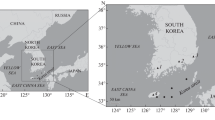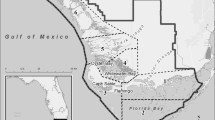Abstract
Possible changes in the feeding habits and trophic niche width of rainbow runner, Elagatis bipinnulata, were investigated using stomach content analysis (SCA) and stable isotope analysis (SIA). A total of 380 samples were collected as bycatch from tuna purse seine in the western and central Pacific Ocean (WCPO) from 2010 to 2015. The results indicated that the prey groups of E. bipinnulata were composed of fish (74.8%, % by frequency of occurrence), crustaceans (7.0%), cephalopods (2.8%), and digestive mucous with prey wreckage (15.4%). The main species found in the stomach was Decapterus macarellus. There was no obvious variation in the nitrogen stable isotope ratios (δ15N) among fork length (FL) classes when the smallest size group was not considered. In contrast, there was a significant shift in the carbon stable isotope ratios (δ13C) between individuals < 55 cm FL and > 55 cm FL (p < 0.01). Additionally, the trophic niche width of E. bipinnulata represented by the corrected standard ellipse area (SEAc) indicated that the trophic niches of E. bipinnulata may behave differently in different size classes because of the variance in feeding ecology or prey preferences at 55–65 cm FL.





Similar content being viewed by others
Data availability
Data will be available upon reasonable request.
Code availability
Not applicable.
References
Amandè JM, Shonnon CC, Miguel NDS (2016) Rapport de la réunion intersession de 2017 du groupe d’espèces sur les thonidés tropicaux. Collect Vol Sci Pap ICCAT 74(5):1873–1954
Andrade CAA (2001) Las corrientes superficiales en la cuenca de Colombia observadas con boyas de deriva. Revista Acad Colomb Ci Exact 25(96):321–336
Baldwin CC (2003) FAO species identification guide for fishery purposes. The living marine resources of the Western Central Pacific. Copeia 2003(1):212–214
Bearhop S, Adams CE, Waldron S, Fuller RA, MacLeod H (2004) Determining trophic niche width: a novel approach using stable isotope analysis. J Anim Ecol 73(5):1007–1012
Blondel J, Chessel D, Frochot B (1988) Bird species impoverishment, niche expansion, and density inflation in Mediterranean island habitats. Ecology 69(6):1899–1917
Bocanegra Castillo N (2007) Relaciones tróficas de los peces pelágicos asociados a la pesquería del atún en el océano Pacífico oriental. Instituto Politécnico Nacional. Centro Interdisciplinario de Ciencias Marinas
Brunnschweiler JM, Sazima I (2010) Swift swimming reef fish as hosts of small juvenile sharksuckers. Coral Reefs 29(4):843–843
Castro E, Grandas Y, García C (2007) Conocimiento pesquero tradicional: Aplicación del Análisis de Consenso Cultural para la evaluación y el manejo de la pesquería artesanal del la Isla de San Andrés, Colombia. Proc Gulf Caribb Fish Inst 58:117–122
Clegg SM, Owens PF (2002) The ‘island rule’ in birds: medium body size and its ecological explanation. P Roy Soc Lond B Bio 269(1498):1359–1365
Criales-Hernández MI, García CB, Wolff M (2006) Flujos de biomasa y estructura de un ecosistema de surgencia tropical en La Guajira Caribe Colombiano. Revista De Biología Tropical 54(4):1257–1282
Dambacher JM et al (2010) Analyzing pelagic food webs leading to top predators in the Pacific Ocean: a graph-theoretic approach. Prog Oceanogr 86(1–2):152–165
DeNiro MJ, Epstein S (1978) Influence of diet on the distribution of carbon isotopes in animals. Geochim Cosmochim Acta 42(5):495–506
DeNiro MJ, Epstein S (1981) Influence of diet on the distribution of nitrogen isotopes in animals. Geochim Cosmochim Acta 45(3):341–351
Diamond JM (1970) Ecological consequences of island colonization by southwest Pacific birds, I. Types of niche shifts. Proc Natl Acad Sci 67(2):529–536
Espinoza M, Clarke TM, Villalobos-Rojas F, Wehrtmann IS (2012) Ontogenetic dietary shifts and feeding ecology of the rasptail skate Raja velezi and the brown smoothhound shark Mustelus henlei along the Pacific coast of Costa Rica, Central America. J Fish Biol 81(5):1578–1595
Ferry LA, Cailliet GM (1996) Sample size and data analysis: are we characterizing and comparing diet properly? In: Mackinley D, Shearer K (eds) Feeding Ecology and Nutrition in Fish. In American Fisheries Society Symposium, San Francisco, pp 70–81
Florentine AN, Constance DN, Justin AM, Paul AKJ, Abekan E, Marie GA (2019) Diet of Elagatis bipinnulata (Guoy & Gaimard, 1824) in Côte d’Ivoire (Gulf of Guinea). Eur Sci J 15:131–142
García Rami CB, Posada C (2014) First approach to the trophic ecology and diet of the rainbow runner, Elagatis bipinnulata (Quoy & Gaimard, 1825) (Pisces: Carangidae), in the central Colombian Caribbean. Acta Biol Colom 19(2):309–314
Graham BS, Grubbs D, Holland K, Popp BN (2007) A rapid ontogenetic shift in the diet of juvenile yellowfin tuna from Hawaii. Mar Biol 150(4):647–658
Harrigan P, Zieman J, Macko S (1989) The base of nutritional support for the gray snapper (Lutjanus griseus): an evaluation based on a combined stomach content and stable isotope analysis. Bull Mar Sci 44(1):65–77
Hesslein RH, Hallard K, Ramlal P (1993) Replacement of sulfur, carbon, and nitrogen in tissue of growing broad whitefish (Coregonus nasus) in response to a change in diet traced by δ34S, δ13C, and δ15N. Can J Fish Aquat Sci 50(10):2071–2076
Hiatt RW, Strasburg DW (1960) Ecological relationships of the fish fauna on coral reefs of the Marshall Islands. Ecol Monogr 30(1):65–127
Hobson KA, Clark RG (1992) Assessing avian diets using stable isotopes I: turnover of 13C in tissues. Condor 94(1):181–188
Iwasaki Y (1998) Maturity and feeding habits of rainbow-runner, Elagatis bipinnulatus, in the western Pacific Ocean. J Sch Mar Sci Technol Tokai Univ 46:33–40
Jackson AL, Inger R, Parnell AC, Bearhop S (2011) Comparing isotopic niche widths among and within communities: SIBER–Stable Isotope Bayesian Ellipses in R. J Anim Ecol 80(3):595–602
Langley AD, Williams PG, Hampton J (2005) The western and central Pacific tuna fishery: 2003 overview and status of stocks. Secretariat of the Pacific Community
Layman CA, Arrington DA, Montaña CG, Post DM (2007) Can stable isotope ratios provide for community-wide measures of trophic structure? Ecology 88(1):42–48
Livingston RJ (1982) Trophic organization of fishes in a coastal seagrass system. Mar Ecol Prog Ser 7(1):1–12
MacAvoy SE, Macko SA, Garman GC (2001) Isotopic turnover in aquatic predators: quantifying the exploitation of migratory prey. Can J Fish Aquat Sci 58(5):923–932
McDonald RA (2002) Resource partitioning among British and Irish mustelids. J Anim Ecol 71(2):185–200
O’reilly C, Hecky R, Cohen A, Plisnier P-D (2002) Interpreting stable isotopes in food webs: recognizing the role of time averaging at different trophic levels. Limnol Oceanogr 47(1):306–309
Pensinger LG, Polito MJ, Midway SR (2021) Ontogenetic stability in the trophic niche of a common Gulf of Mexico fish, Ariopsis felis. Environ Biol Fish 104(5):569–579
Pinheiro PB, Hazin FHV, Travassos P, Oliveira PGV, Carvalho F, Rêgo MG (2011) The reproductive biology of the rainbow runner, Elagatis bipinnulata (Quoy & Gaimard, 1825) caught in the São Pedro and São Paulo Archipelago. Braz J Biol 71:99–106
Post DM (2002) Using stable isotopes to estimate trophic position: models, methods, and assumptions. Ecology 83(3):703–718
Rodger AW, Starks TA (2021) Ontogenetic diet shift, feeding ecology, and trophic niches of the redspot chub (Cypriniformes: Cyprinidae: Nocomis asper). Ichthyol Herpetol 109(3):796–805
Saito H, Yamashiro R, Ishihara K, Xue C (1999) Lipids of three highly migratory fishes: Euthynnus affinis, Sarda orientalis, and Elagatis bipinnulata. Biosci Biotechnol Biochem 63(11):2028–2030
Senta T, Kimura M, Kanbara T (1993) Predation of fishes on open-ocean species of sea-skaters (Halobates spp.). Jpn J Ichthyol 40(2):193–198
Shimose T, Shono H, Yokawa K, Saito H, Tachihara K (2006) Food and feeding habits of blue marlin, Makaira nigricans, around Yonaguni Island, southwestern Japan. Bull Mar Sci 79(3):761–775
Vaske Júnior T, Hazin FHV, Lessa RP (2006) Pesca e hábitos alimentares do peixe-rei, Elagatis bipinnulata (Quoy & Gaimard, 1825) (Pisces: Carangidae) no arquipélago de São Pedro e São Paulo, Brasil. Arquivo De Ciências Do Mar Fortaleza 39(1):61–65
Watkins WA, Daher MA, Fristrup K, Notarbartolo di Sciara G (1994) Fishing and acoustic behavior of Fraser’s dolphin (Lagenodelphis hosei) near Dominica, southeast Caribbean. Carib J Sci 30(1–2):76–82
Werner EE, Gilliam JF (1984) The ontogenetic niche and species interactions in size-structured populations. Annu Rev Ecol Syst 15:393–425
Wu G, Berger WH (1989) Planktonic foraminifera: differential dissolution and the Quaternary stable isotope record in the west equatorial Pacific. Paleoceanography 4(2):181–198
Yoshioka T, Wada E, Hayashi H (1994) A stable isotope study on seasonal food web dynamics in a eutrophic lake. Ecology 75(3):835–846
Zahn R, Pedersen TF, Bornhold BD, Mix AC (1991) Water mass conversion in the glacial subarctic Pacific (54°N, 148°W): physical constraints and the benthic-planktonic stable isotope record. Paleoceanography 6(5):543–560
Acknowledgements
We thank Xu Guoqiang and the seaman in the tuna purse seiners Jinhui No.7 and Jinhui No.9 for their assistance with sample collection at sea. We also thank Yang Qingyuan, Zhang Haiting, Liu Wei, and Dr. Zhou Cheng for their assistance with preparatory isotope analysis and stomach content analysis. We would like to acknowledge Dr. Lin Dongming, Dr. Han Dongyan, and Dr. Gong Yi for their great help in revising the manuscript. The stable isotope composition was measured at the Key Laboratory of Sustainable Exploitation of Oceanic Fisheries Resources, Ministry of Education, Shanghai Ocean University.
Funding
This research was funded by the National Key R&D Programs of China (Grant No. 2019YFD0901404).
Author information
Authors and Affiliations
Contributions
Conceptualization: S.W. and X.W.
Methodology: L.X. and S.T.
Software: S.W. and X.W.
Validation: S.W. and X.W.
Formal analysis: S.W.
Investigation: X.W.
Resources: L.X.
Data curation: S.W.
Writing—original draft preparation: S.W.
Writing—review and editing: X.W and L.X.
Visualization: X.W.
Supervision: X.W. and S.T.
Project administration: L.X.
Funding acquisition: L.X. and S. T.
All authors have read and agreed to the published version of the manuscript.
Corresponding author
Ethics declarations
Ethics approval
Specimens were not alive after being caught, and then the scientific observers collected samples for this study. The specimens were analyzed in laboratory using methods that are in line with current Chinese national standards, namely Laboratory animals-General requirements for animal experiment (GB/T 35823–2018).
Consent to participate
Not applicable.
Consent for publication
All authors have read the manuscript and consent to publication.
Conflict of interest
The authors declare no competing interests.
Additional information
Publisher’s note
Springer Nature remains neutral with regard to jurisdictional claims in published maps and institutional affiliations.
Rights and permissions
About this article
Cite this article
Wang, S., Wang, X., Xu, L. et al. Feeding habits and trophic niche of rainbow runner Elagatis bipinnulata in the western and central Pacific Ocean. Environ Biol Fish 105, 139–149 (2022). https://doi.org/10.1007/s10641-021-01200-w
Received:
Accepted:
Published:
Issue Date:
DOI: https://doi.org/10.1007/s10641-021-01200-w




